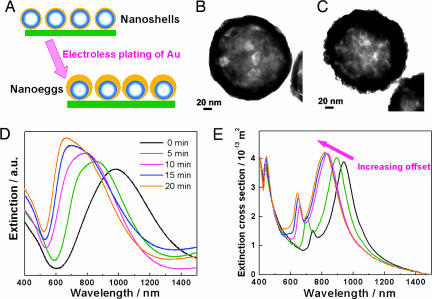Fig. 2.
Synthesis of nanoshells with a nonconcentric core. (A) Schematic of nanoegg fabrication. Monolayers of silica–Au core–shell nanoparticles were first immobilized on PVP-functionalized glass slides. The nanoshells used in this set of experiments are 94 ± 9 nm in core radius and 9 ± 1 nm in shell thickness. By controlling the reaction time, the offset extent can be controlled. Longer reaction time results in the formation of nanoeggs with larger offset cores. (B and C) TEM images of a nanoshell (B) and nanoegg (C). (D) Experimentally measured evolution of extinction spectra of oriented monolayer nanoegg film during metallization with unpolarized optical excitation at normal incidence. (E) Calculated normal incidence extinction spectra (FDTD) of reduced symmetry nanoparticles as a function of increasing offset. In this set of calculations, the nanoeggs have a silica core of 94 nm in radius. The thinnest part of the shell is 9 nm, and the thickest part of the shell is 9 nm for concentric nanoshell and varied to be 15, 21, 27, and 33 nm for nanoeggs.

